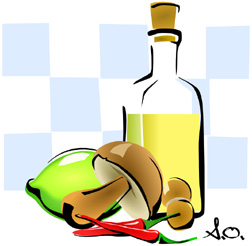
Remember that crazy emperor Nero and his mad use of saffron? Well his extravagance shows up again in the history of cinnamon. In a fit of remorse, he burned a year’s supply of this expensive, coveted spice at the funeral of his wife Poppaea Sabina, whom he murdered in 65 A.D.
Now, fast forward to your 2008 Canadian kitchen where you are using cinnamon for making mulled wine, marinades and all sorts of dishes, right? Or at least, that’s what you think. But chances are you are not using the same spice that Nero burned in dramatic excess. You are probably using cassia, because that’s what’s sold as cinnamon here.
There are two interesting things you should know about cassia.
Firstly, it’s not real cinnamon. Real cinnamon is an inner layer of bark with a soft, crumbly texture. It has many thin layers like the French dessert millefeuille. In contrast, cassia has a stronger flavour and is hard with just one layer of bark, as in the illustration above and this photo from Wikipedia. Europe has a law to truthfully distinguish real cinnamon from cassia, but unfortunately Canada hasn’t yet followed suit!
And that’s a concern, because the second thing you should know about cassia is it contains a plant chemical called coumarin that in high concentrations can cause liver and kidney damage. I don’t know how much is too much, but a moderate intake of cassis is probably still okay. NPR radio’s exposé on coumarin and the case of the German Christmas cookie follows up on this.
Real cinnamon, Cinnamomum verum, is native to Sri Lanka, South India and Indonesia. Its other Latin name, Cinnamomum zeylanicum is derived from Sri Lanka’s former name, Ceylon. It’s from the laurel family, the same family that bay leaves come from.
Real cinnamon was a gift fit for kings. In ancient times, finding it was a big motive for exploration. As early as 2000 B.C., it was imported to Egypt from China. Then Indonesians imported it on rafts on a cinnamon route from the Spice Islands (aka the Maluku Islands) to East Africa, where local traders brought it to the Romans who used it as incense and on funeral pyres. In the Middle Ages, the Venetians controlled trade of cinnamon and other spices to Europe.
The next time you use cinnamon, I hope its age-old history and worth will feed your imagination of eras long passed. And if you ever find a commercial source of real cinnamon, please let us know by leaving a comment!
Saturday, April 26, 2008
History Bites: Cinnamon
Subscribe to:
Post Comments (Atom)









3 comments:
Hey Asha, remember me? Jo, Adrienne's friend from Hamilton. I had a bad cold when I met you on Canada Day.
Good entry. I do love your blog, btw. I did not know the difference between cinnamon and cassia.
I googled 'where to buy real cinnamon' and this place in Wisconsin popped up: http://www.penzeys.com/cgi-bin/penzeys/p-penzeyscinnamon.html
Good luck! Hopefully they ship to Canada!!
I buy Real Cinnamon straight from Ceylon from Dru Era. They ship to USA and Canada within 3 days.
http://www.ceylon-cinnamon.com
Thanks Pat for the link, the Cinnamon tastes so different from the Cassia we have been using for ages
Post a Comment